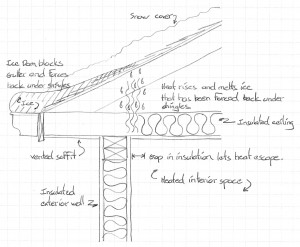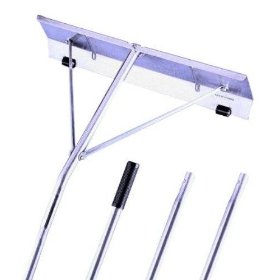Ice Dams
We’ve been dealing with ice dams this winter. Several clients have had issues in locations that they have never occurred before. Usually when they call though, the “dam” comes first and the spelling is different… Often it’s unclear if this new occurrence is due to a change in conditions with the building or an unusual weather pattern.
Ice dams are what occur at the eaves on buildings where snow and ice melt on a roof and the resulting water runs to the edge of the roof and refreezes. The dam actually occurs outside the building wall envelope. Unattended, water created by the dam can cause rot to occur on the roof deck and possibly on structural members, it can saturate insulation causing loss of R value, and eventually damage to interior finishes such as drywall, paint and wood trim.

Typical Ice Dam Condition
The typical ice dam is caused by a combination of poor attic insulation and poor attic ventilation. Heat escapes from inside of the building and into the attic. The heat in the attic warms the roof and causes the snow on the roof to melt. The water from the snow melt runs down the roof towards the eave. As it passes over the exterior wall where the roof hasn’t been warmed, the water refreezes and an ice dam forms. As the ice dam forms, it stops the water from reaching the eave and escaping. As the water refreezes, it expands and pushes back up the roof and often under the shingles. As it pushes up under the shingles, it breaches the weathertight barrier. As it passes back over the exterior wall, it gets back to the warm area and thaws again. The resulting water then drips in the attic. This is when the water problem occurs and is often the first time the ice dam becomes apparent.
Other causes can be improperly insulated heat ducts in the attic, improperly insulated hot water pipes, improperly vented exhaust fans, or attic equipment that produces heat as a by-product of its operation, i.e., some heat source in the attic outside the insulated building envelope.
In general, the attic of a building should be kept as cool as possible. This is a rule that applies in both winter and summer. In the winter, the underside of the roof should remain cool to prevent thawing of snow and ice on the roof and the resulting ice dams at the eave. In the summer, keeping the roof cool will extend the life of the weatherproofing, whether it is shingles, built-up or other forms of waterproof membrane. Proper venting at the eaves accompanied by proper venting at the ridge create a chimney effect which draws cool in from the eave which travels along the under surface of the roof to the vents at the ridge.
The problem is most severe in uninsulated structures where heat is introduced. An example would be a cabin with open rafters. Often venting is not provided on these structures in order to provide a tighter structure for use in Spring and Fall. If temporary heat is introduced, the heat naturally rises, warming the roof deck and causing melting of snow. If there is an eave overhang, refreezing and ice dams will occur.
If ice dams occur regularly and changes to the structure or underlying conditions are not possible, one solution is removal of the snow. I suppose it is a testimony to how common this occurrence is when there are multiple commercial applications available as remedies. One solution is a roof rake. The one at the right is one of several available at Amazon.com Another solution is a roof mounted electric heating cable that is placed along the eave to melt ice dams as they form. Both of these require action to be taken before the ice dam forms, i.e., removing the snow with the rake or activating the electric heating element.
After an ice dam has formed, cures include chipping the ice dam away physically, applying an ice melt substance such as Calcium Chloride or for the extremely ambitious, applying a heat source. I have read of other colorful methods of removing ice dams, but lest I be accused of endorsing them, I will let you find or come up with those on your own. There is a definite danger factor in any of these solutions as they involve climbing on an icy roof and/or setting up a ladder against and possibly on ice. Extreme caution should be exercised if you attempt to remove an ice dam. Also, aside from danger to your person, care should be exercised to prevent damage to your roof and gutters. The leak caused from the ice dam will not be improved by holes created by over zealous attacks on your roof with a hammer, pick or other implements of destruction. Wear safety goggles as flying chips of ice could damage your eyes and Calcium Chloride is an irritant to skin and eyes. (Calcium Chloride MSDS here.)
If you choose to try the ice melt, Calcium Chloride is generally considered a safe option. Rock salt will stain your shingles and could damage gutters.
Amazon.com sells a “sock” that you can put the calcium chloride in to better control it. The do-it-yourself option for this is to use an old pair of pantyhose. Removing large ice dams must be done with care, particularly when there is a gutter involved. While leaving the ice dam in place can destroy the gutter with the pressure of expansion, there is the possibility of damaging the gutter by removing the ice from the roof and leaving the ice at the gutter where the unsupported weight can deform it. It is generally recommended to create channels in the ice dam by selectively melting it, thus allowing a path for the water to escape without creating a structural problem within the dam.
In general, it is better to determine the underlying cause of the ice dam as it relates to the building and prevent it from happening again. Correcting insulation, venting or heating problems are the long term solutions and are safer and more reliable.




By Darin February 3, 2010 - 12:22 pm
Great story with some good points on how to prevent ice dams. Another option to consider is the easy retrofit of a Thermal Technologies roof deicing system for a home’s roof eaves and valley’s. It will permanently solve any ice dam issues cause by heat loss from the home, radiant heat from the sun, difficult exposure, poor architectural designs…. the list goes on. There can be many challenges to trying to fix a poorly designed home and attic structure. Check them out at http://www.thermaltechusa.com.
By Attic Insulation « Easterday Construction January 26, 2011 - 2:29 pm
[…] […]
By Snow Loads :: Easterday Construction February 13, 2013 - 1:19 pm
[…] For a couple of other related, cold weather, roof posts, see one on attic insulation here and one on ice dams here. […]
By Would Your New House Look Good in High Heels? :: Easterday Construction August 19, 2013 - 2:29 pm
[…] I’m not talking about stripper shoes! I’m talking about truss construction. This is something we’re seeing and recommending more in new construction. Installing a truss with a raised heel detail allows for more insulation at the perimeter where often the insulation is compressed or absent due to the proximity of the interior ceiling to the roof deck. The detail to the right shows how a standard truss is built. As discussed here before, venting and insulation is important to shingle life and to prevent ice damming. […]